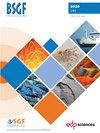法国东南部比利牛斯-普罗旺斯冲断带的构造样式与演化
IF 2.6
3区 地球科学
Q2 GEOSCIENCES, MULTIDISCIPLINARY
引用次数: 25
摘要
比利牛斯-普罗旺斯褶皱冲断带的地质复杂性是由于构造历史的叠加和变形在古生代和中生代承袭的非均质力学基底中传播而形成的。区域平衡剖面的构建结合野外资料表明,东南Provence地区逆冲构造具有厚皮与薄皮混合的构造样式,与深层晚古生代—三叠纪伸展构造的反转和三叠纪以上中新生代沉积盖层的脱脱有关。最早的盖诺曼尼亚恢复状态突出了下白垩世沉积系北掐出的主要长波长朗斯高隆起之上。最新的三东期恢复状态表明,由于比利牛斯-普罗旺斯三棱镜的初始生长控制了前陆的外部弯曲,盆地向南倾斜了~2°。在晚白垩世至始新世,比利牛斯-普罗旺斯褶皱冲断带北部的逆冲活动是同步的,形成了向南~7°的盆地倾斜。这主要是构造逆转和西西里盖-圣波姆单元基底逆冲叠加的结果。横截面平衡显示,整个比利牛斯-普罗旺斯前陆的水平基底总缩短了40公里(~ 35%)。这种缩短的主要部分(~37 km)是由弧向斜以南基底的厚皮逆冲调节的。由深部厚皮间逆冲楔体转移的滑移导致的向北的弧形向斜和东部的Sainte-Victoire薄皮构造容纳了约5 km的缩短。最后将普罗旺斯东南部的盐构造解释为侏罗纪至晚白垩世被动底辟作用生长,然后在比利牛斯-普罗旺斯挤压期间重新激活。渐新世伸展期与假定反应性底辟作用有关的晚期正断层主要局限于继承性盐构造之上,可能受继承性基底断裂控制。本文章由计算机程序翻译,如有差异,请以英文原文为准。
Structural style and evolution of the Pyrenean-Provence thrust belt, SE France
The Pyrenean-Provence fold-thrust belt is characterized by a geological complexity arising from superimposed tectonic history and the propagation of the deformation through a heterogeneous mechanical substratum inherited from Paleozoic and Mesozoic times. The construction of a regional balanced cross section together with field data show that the thrust system of the southeastern Provence region is characterized by a mixed thick- and thin-skinned tectonic style related to the inversion of deep-seated late Paleozoic-Triassic extensional structures and the decollement of the Mesozoic-Cenozoic sedimentary cover above Triassic series. Earliest Cenomanian restoration state highlights the northward pinched-out of the Lower Cretaceous sedimentary series above the main long-wavelength Durance High uplift. Latest Santonian restoration state indicates a southward tilting of ~2° of the basin attributed to the initial growth of the Pyrenean-Provence prism controlling the external flexure of the foreland. Thrusts propagation in the northern part of the Pyrenean-Provence fold-thrust belt was recorded to be synchronous during latest Cretaceous to Eocene time and produced a ~7° southward basin tilting. This major tilting is attributed to the tectonic inversion and basement thrust stacking of the Cap Sicie-Sainte Baume units. Cross section balancing shows a total horizontal basement shortening of 40 km (~35 %) across the Pyrenean-Provence foreland. The main part of this shortening (~37 km) was accommodated by thick-skinned thrusts involving basement south of the Arc syncline. ~5 km of shortening were accommodated northward by the Arc syncline and eastern Sainte-Victoire thin-skin structures, resulting from slip transferred from the deep thick-skinned intercutaneous thrust wedge. Finally we interpret salt tectonic structures of the southeastern Provence as passive diapirism growth during Jurassic to late Cretaceous time, and then reactivated during Pyrenean-Provence compression. Late normal faulting related to hypothetical reactive diapirism during the Oligocene extension episode was predominantly localized above inherited salt structures and probably controlled by inherited basement faults.
求助全文
通过发布文献求助,成功后即可免费获取论文全文。
去求助
来源期刊
CiteScore
5.80
自引率
0.00%
发文量
18
审稿时长
>12 weeks
期刊介绍:
BSGF - Earth Sciences Bulletin publie plusieurs types de contributions :
1. des articles originaux, couvrant tous les champs disciplinaires des Géosciences, à vocation fondamentale mais également à vocation plus appliquée (risques, ressources);
2. des articles de synthèse, faisant le point sur les avancées dans un domaine spécifique des Géosciences, qu''elles soient méthodologiques ou régionales ;
3. des monographies sur la géologie d’une région donnée, assorties d’informations supplémentaires, cartes, coupes, logs, profils sismiques … publiées en ligne en annexe de l’article ;
4. des articles courts de type « express letter » ;
5. des livrets-guides d’excursion (qui suivront le même processus d’examen éditorial que les articles plus classiques) ;
6. des comptes rendus de campagnes à la mer ;
7. des articles de données géodésiques, géophysiques ou géochimiques, pouvant devenir des articles de référence pouvant conduire à des interprétations ultérieures.
BSGF - Earth Sciences Bulletin constitue également un forum pour les discussions entre spécialistes des Sciences de la Terre, de type comment-reply ou autre. Tous les articles publiés, quelle que soit leur forme, seront accessibles sans frais (articles en Open Access) sur le site de la SGF et sur celui de Geosciences World dans la mesure où les auteurs se seront acquittés d’une contribution de (Article Processing Charges – APC) de 300€ pour les membres de la SGF et 500€ pour les non-membres.

 求助内容:
求助内容: 应助结果提醒方式:
应助结果提醒方式:


